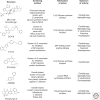Antifungal drug development: challenges, unmet clinical needs, and new approaches
- PMID: 24789878
- PMCID: PMC3996373
- DOI: 10.1101/cshperspect.a019703
Antifungal drug development: challenges, unmet clinical needs, and new approaches
Abstract
Invasive, life-threatening fungal infections are an important cause of morbidity and mortality, particularly for patients with compromised immune function. The number of therapeutic options for the treatment of invasive fungal infections is quite limited when compared with those available to treat bacterial infections. Indeed, only three classes of molecules are currently used in clinical practice and only one new class of antifungal drugs has been developed in the last 30 years. Here we summarize the unmet clinical needs of current antifungal therapy, discuss challenges inherent to antifungal drug discovery and development, and review recent developments aimed at addressing some of these challenges.
Figures



References
-
- Bicanic T, Muzoora C, Brouwer AE, Meintjes G, Longley N, Taseera K, Rebe K, Loyse A, Jarvis J, Bekker LG, et al. 2009. Independent association of clearance of infection and clinical outcome of HIV-associated cryptococcal meningitis: Analysis of combined cohort of 262 patients. Clin Infect Dis 49: 702–709 - PMC - PubMed
-
- Bills GF, Platas G, Overy DP, Collado J, Fillola A, Jiménez MR, Martín J, del Val AG, Vicente F, Tormo JR, et al. 2009. Discovery of the parnafungins, antifungal metabolites that inhibit mRNA polyadenylation, from the Fusarium larvarum complex and other Hypocrealean fungi. Mycologia 101: 449–472 - PubMed
-
- Boucher HW, Talbot GH, Bradley JS, Edwards JE, Gilbert D, Rice LB, Scheld M, Spellberg B, Bartlett J 2009. Bad bugs, no drugs: No ESKAPE! An update from the Infectious Diseases Society of America. Clin Infect Dis 48: 1–12 - PubMed
Publication types
MeSH terms
Substances
Grants and funding
LinkOut - more resources
Full Text Sources
Other Literature Sources
Medical
